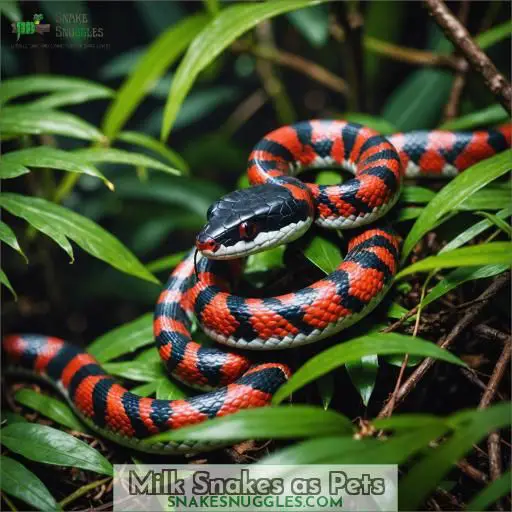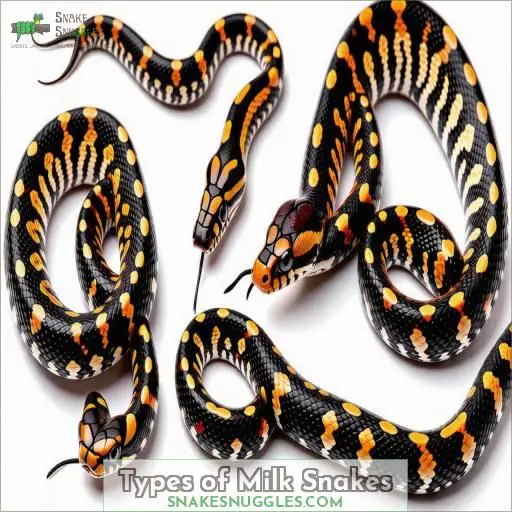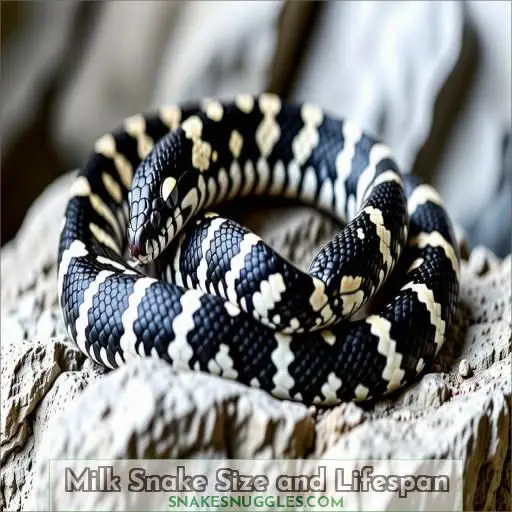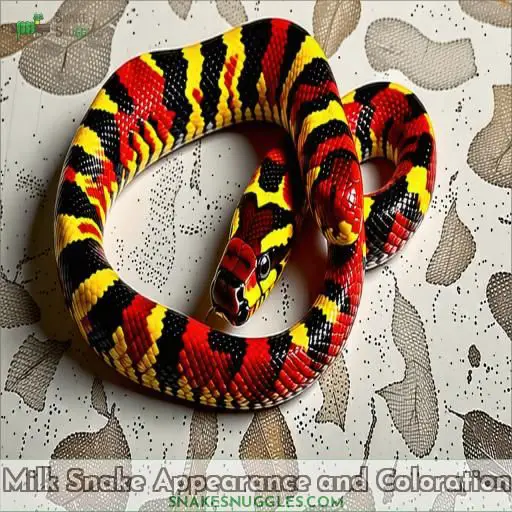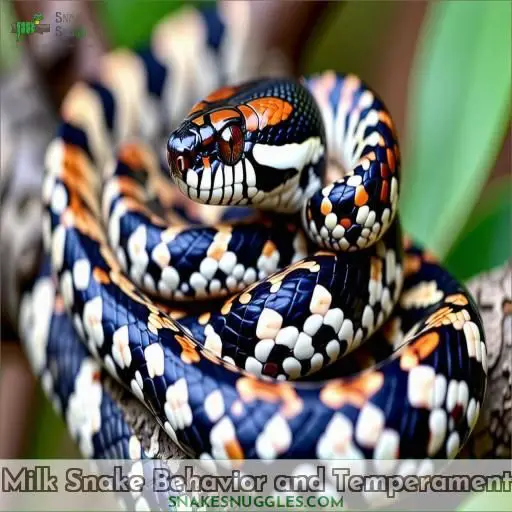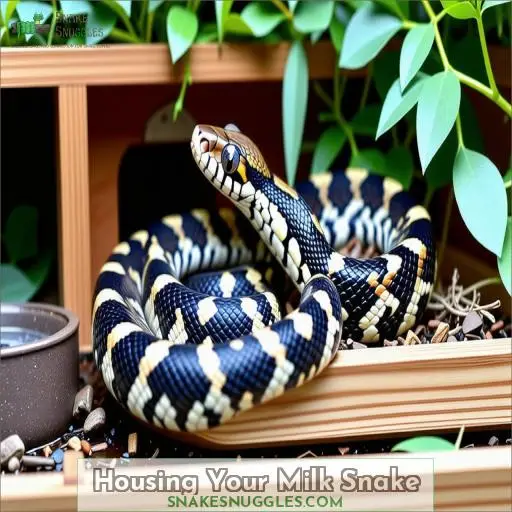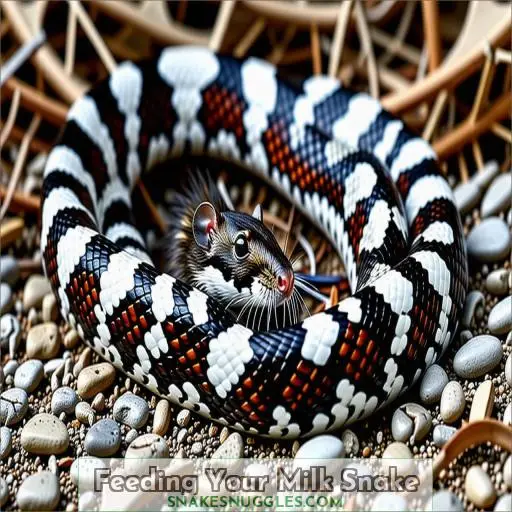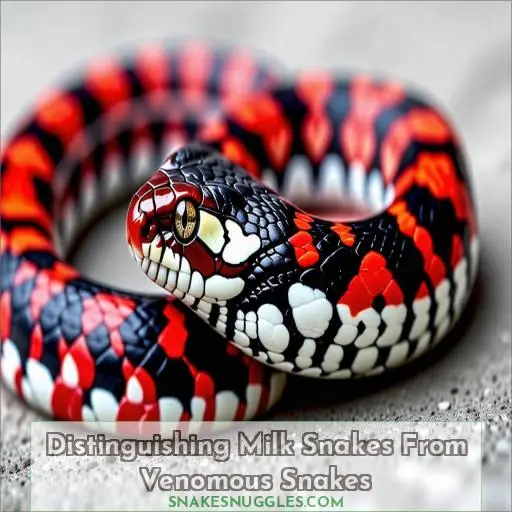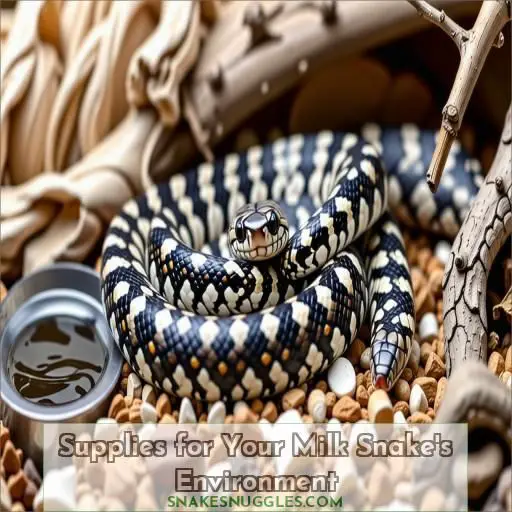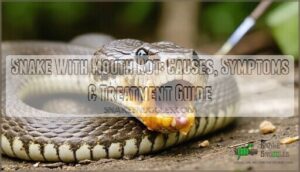This site is supported by our readers. We may earn a commission, at no cost to you, if you purchase through links.
 Milk snakes make fantastic pets due to their docile nature and striking patterns.
Milk snakes make fantastic pets due to their docile nature and striking patterns.
As a new owner, you’ll appreciate their calm temperament – they rarely bite and are gentle when handled.
With proper care, these non-venomous beauties can live over 20 years, making them a rewarding long-term companion.
Housing is straightforward, and they readily accept frozen-thawed rodents.
While relatively small, some subspecies can reach up to 7 feet, so choose an appropriately sized habitat.
Their eye-catching banded colors mimic venomous snakes as a defense mechanism.
But don’t worry, milk snakes are harmless and ideal for reptile enthusiasts seeking an enchanting, low-maintenance pet.
Continue reading to discover the full potential of milk snake ownership.
Table Of Contents
- Key Takeaways
- Milk Snakes as Pets
- Types of Milk Snakes
- Milk Snake Size and Lifespan
- Milk Snake Appearance and Coloration
- Milk Snake Behavior and Temperament
- Housing Your Milk Snake
- Feeding Your Milk Snake
- Common Health Issues in Milk Snakes
- Distinguishing Milk Snakes From Venomous Snakes
- Supplies for Your Milk Snake’s Environment
- Frequently Asked Questions (FAQs)
- Do milk snakes like being held?
- What size tank does a milk snake need?
- Do milk snakes like to dig?
- Are milk snakes aggressive?
- How do I introduce a new milk snake to its enclosure?
- Can milk snakes be housed together safely?
- How often should I handle my milk snake?
- What are the signs of a healthy milk snake?
- How can I tell if my milk snake is stressed?
- Conclusion
Key Takeaways
- Milk snakes are ideal pets due to their docile nature, calm temperament, and longevity of over 20 years.
- They are strict carnivores, primarily feeding on rodents, and readily accept frozen-thawed prey in captivity.
- Different subspecies of milk snakes have striking color patterns and manageable sizes, making them suitable for both beginner and experienced reptile enthusiasts.
- Proper care for milk snakes includes providing appropriate housing with hiding spots, ensuring proper temperatures, humidity, and feeding schedules for their well-being.
Milk Snakes as Pets
Milk snakes make wonderful pets for both beginners and experienced reptile enthusiasts.
These docile, non-venomous snakes are easy to care for and come in a variety of striking color patterns.
With proper housing, diet, and health care, milk snakes can thrive in captivity for over 20 years.
Their calm temperament and manageable size make them ideal for handling, though it’s important to always supervise interactions.
Milk snakes are strict carnivores, feeding primarily on rodents in the wild.
In captivity, they readily accept frozen-thawed prey.
Providing the right environment, including proper temperatures, humidity, and hiding spots, is essential for their well-being.
Types of Milk Snakes
There are several fascinating varieties of milk snakes that make excellent pets for reptile enthusiasts. The Andean milk snake, Atlantic Central American milk snake, black milk snake, Blanchard’s milk snake, and Central Plains milk snake are among the most commonly kept subspecies due to their manageable sizes, docile temperaments, and striking color patterns.
Andean Milk Snake
The Andean milk snake, native to South America, thrives in diverse habitats. It requires a secure terrarium with hiding spots, thermal gradient, and appropriate food and water sources for adequate care.
- Habitat: Mountainous regions, forests, grasslands
- Reproduction: Oviparous, lays 5-15 eggs
- Captive Breeding: Possible with proper conditions
Atlantic Central American Milk Snake
The Atlantic Central American milk snake is found in parts of Mexico and Central America. These snakes inhabit tropical forests and prefer humid environments. They’re known for their striking banded patterns.
Black Milk Snake
The black milk snake, with its striking black and white banded pattern, is an alluring subspecies. These docile snakes thrive in secure enclosures, relishing a varied rodent-based diet.
Blanchard’s Milk Snake
The Blanchard’s milk snake, a stunning subspecies, thrives in diverse habitats. Its genetics, conservation, and lifespan make it an intriguing choice for experienced reptile enthusiasts. Provide an appropriate enclosure with proper heat, light, and humidity for its care.
Central Plains Milk Snake
The Central Plains milk snake, found in the central United States, is a hardy, easy-to-keep pet snake with beautiful patterns and a calm temperament. Its habitat includes prairies, woodlands, and rocky areas. Conservation efforts aim to protect this species.
| Habitat | Temperament | Defense Mechanisms |
|---|---|---|
| Prairies | Calm | Musk secretion |
| Woodlands | Hardy | Batesian mimicry |
| Rocky areas | Easy to keep | Beautiful patterns |
Milk Snake Size and Lifespan
As you delve into the intriguing world of milk snakes, it’s essential to grasp the dynamics of their size and lifespan. These mesmerizing creatures exhibit a diverse range of growth patterns and longevity, influenced by factors such as subspecies, genetics, and captive care.
Most adult milk snakes measure between 36 to 48 inches long, although certain subspecies can reach up to 7 feet. Their size is influenced by factors such as:
- Growth rates
- Sexual maturity
- Genetic variations
- Captive breeding
- Morph availability
In captivity, milk snakes can live a remarkable 20 to 30 years, far surpassing their wild counterparts. This extended lifespan is a testament to the dedicated care and attention they receive from responsible owners. By understanding the intricacies of milk snake size and longevity, you can provide these fascinating companions with the ideal environment to thrive throughout their long and vibrant lives.
Milk Snake Appearance and Coloration
Regarding the aesthetics of milk snakes, their striking and distinctive patterns will mesmerize you.
These snakes are renowned for their signature ringed color patterns, frequently featuring a combination of red, black, and white or yellow bands.
The specific color combinations can vary significantly depending on the geographic region and subspecies.
Some milk snakes even mimic the appearance of venomous coral snakes as a defense mechanism, with adjacent red and black bands.
In captivity, breeders have developed a wide array of captive-bred color morphs, allowing you to select a milk snake with truly dazzling and one-of-a-kind patterns.
Regardless of the specific coloration, milk snakes are undeniably beautiful reptiles that will enhance the visual appeal of your secure enclosure.
Milk Snake Behavior and Temperament
Milk snakes are renowned for their docile temperament, making them suitable pets for both novice and experienced reptile enthusiasts.
These fascinating creatures are generally calm and gentle, rarely striking unless provoked.
Their feeding habits are uncomplicated, as they readily accept frozen-thawed rodents in captivity.
As for handling, milk snakes can be picked up with confidence, as their bites aren’t painful and they don’t possess venom.
However, it’s crucial to remember that they may release a musky scent as a defense mechanism when threatened.
Breeding programs have produced a wide array of stunning color variations, further enhancing their appeal as pets.
With proper handling techniques and an understanding of their behavior, milk snakes can make rewarding and low-maintenance companions for years to come.
Housing Your Milk Snake
When housing your milk snake as a pet, the enclosure size should be appropriate for the snake’s length.
A 40-gallon tank is recommended for an adult around 4 feet long.
Use a loose substrate like cypress mulch or coconut fiber to allow burrowing.
Place hiding spots like logs or rocks for security.
Provide a sturdy water dish that’s large enough for the snake to soak in.
Enclosure Size
When housing your milk snake, the enclosure size is essential. Consider dimensions suitable for hatchlings, medium-sized adults, and large adults. Maintain the necessary temperature gradient, humidity levels, ventilation requirements, and lighting considerations for a comfortable and safe environment. (Source)
Substrate
Use a dry substrate like aspen shavings or reptile bark to maintain proper humidity levels of 40-60%. Clean the substrate weekly and keep it at least 2-3 inches deep for burrowing.
Hiding Spots
Provide your milk snake with ample hiding spots, such as hollow logs, rocks, and plants, to feel secure and reduce stress. Offer cover objects in both the warm and cool ends of the enclosure for thermoregulation.
Water
Provide your milk snake with a shallow water dish to maintain proper humidity and aid in shedding. Make certain the water is clean and changed regularly to prevent dehydration and bacterial growth.
Feeding Your Milk Snake
When feeding your milk snake, it’s imperative to prioritize the appropriate growth rate, feeding frequency, and diet diversity. These snakes are strict carnivores, primarily consuming small rodents like mice and rats (Source). The feeding frequency varies with the age of the snake – adult milk snakes are typically fed once or twice a week, while young snakes might require slightly more frequent feeding . When considering prey preference, captive milk snakes readily eat frozen-thawed food, which provides a convenient and safe option compared to live prey . Using frozen-thawed food also eliminates the risk of the snake being injured by live prey. As you nourish your pet milk snake, maintaining a balanced and consistent feeding schedule is essential for its health and wellbeing (Source).
| Feeding Aspect | Considerations |
|---|---|
| Growth Rate | Guarantee steady growth through appropriately sized prey and a schedule conducive to healthy development |
| Feeding Frequency | Adjust feeding frequency based on the age of the snake, generally once or twice a week for adult snakes |
| Diet Variety | Offer a varied diet of small rodents to ensure optimal nutrition and prevent dietary monotony |
| Prey Preference | Frozen-thawed food is a safe and convenient option, eliminating the risks associated with live prey |
Common Health Issues in Milk Snakes
As with any pet, milk snakes can occasionally experience health issues that require attentive care. Common problems include mites, mouth rot, dry skin, and respiratory infections. Mites appear as white, red, or black dots moving around the snake’s body, while mouth rot presents as a yellow, cheesy substance coating the mouth. Dry skin manifests as patchy sheds and difficulty shedding the eyecaps. Respiratory infections cause wheezing, open-mouth breathing, and fluid or crusty secretions around the nostrils.
Promptly address these concerns by consulting a reptile veterinarian. Maintain proper humidity, temperature, and hygiene in the enclosure to prevent many health issues. Quarantine new snakes and monitor closely for signs of parasites or illness. With diligent care, your milk snake can live a long, healthy life as your exceptional companion.
Distinguishing Milk Snakes From Venomous Snakes
Distinguishing milk snakes from venomous species is essential for responsible snake ownership. While milk snakes are harmless constrictors often confused with coral snakes or copperheads due to their color patterns, identifying key differences guarantees safe handling and care.
Coral Snakes
Milk snakes are known for their striking resemblance to the venomous coral snake, a phenomenon called Batesian mimicry.
Coral snakes have adjacent red and yellow bands, while milk snakes’ bands are red and black.
This mimicry helps milk snakes deter predators, as coral snakes possess highly potent neurotoxic venom.
Coral snakes are found in the southeastern United States, while milk snakes have a wider geographic distribution across North America.
Both species prefer similar habitats, like wooded areas and grasslands, making their visual distinction important for conservation efforts.
Copperheads
Copperheads, such as the Northern copperhead and Southern Copperhead, display distinctive coloration with hourglass-shaped blotches and prefer wooded, rocky areas as their habitat. They imitate venomous snakes for defense, and while resembling Eastern Milksnakes, they’ve venom and exhibit different behaviors. Understanding these distinctions is crucial to ensure accurate identification and avoid unnecessary alarm.
Supplies for Your Milk Snake’s Environment
Now that you understand the key differences between milk snakes and their venomous counterparts, let’s discuss the essential supplies needed to create a thriving environment for your new pet.
Maintaining proper humidity levels is imperative, so consider investing in a reptile humidifier or placing a large water dish in the enclosure.
An under-tank heating pad or overhead radiant heat source will allow you to establish the ideal thermal gradient.
Be sure the enclosure is secure with a tight-fitting lid to prevent escapes.
As for substrate, options like paper towels, reptile carpeting, or aspen shavings work well.
Finally, provide a shallow water dish to allow your milk snake to soak and stay hydrated.
With the right setup and supplies, you’ll be well on your way to giving your alluring new pet the care it deserves.
Frequently Asked Questions (FAQs)
Do milk snakes like being held?
Like cautiously approaching a serene pond, milk snakes often warm up to gentle handling once trust is built. With patience and proper technique, these calm reptiles frequently enjoy short bouts of interaction with their trusted caretakers.
What size tank does a milk snake need?
Hatchlings need a 10-gallon tank; medium-sized adults, a 20-gallon; and large adults require a 60-gallon enclosure. Provide a thermal gradient, secure lid, and suitable substrate for these docile snakes.
Do milk snakes like to dig?
You’d be astounded by their tunneling tenacity! Milk snakes adore excavating, burrowing in substrate seeking warmth, security or aiding shed cycles. Providing ample digging depth caters to this deep-rooted drive, enriching their enclosure experience.
Are milk snakes aggressive?
No, milk snakes are generally docile and gentle, making them suitable for beginner snake enthusiasts. Their calm temperament and reluctance to bite or act aggressively make them an excellent choice as low-maintenance pets.
How do I introduce a new milk snake to its enclosure?
Don’t worry about stress—gradual acclimation is key. Set up the enclosure first, then gently place the snake inside, offering hides and leaving it undisturbed to adjust on its own schedule.
Can milk snakes be housed together safely?
While milk snakes are generally solitary, you can house multiple together if specific requirements are met. The enclosure must be large, well-ventilated, with ample hiding spots and feeding areas. Proper acclimation and monitoring are essential to prevent territorial conflicts.
How often should I handle my milk snake?
While handling frequency depends on individual temperaments, most experts recommend beginning with brief, gentle sessions once or twice weekly—increasing over time as your snake becomes accustomed.
What are the signs of a healthy milk snake?
A healthy milk snake has clear, bright eyes, sheds smoothly, and promptly strikes at prey items when hungry. Their body is plump without appearing obese, and they move with a vigor indicating good muscle tone.
How can I tell if my milk snake is stressed?
Signs of stress in milk snakes include lethargy, hiding, refusing food, increased aggression, and musk secretion. Guarantee proper temperatures, humidity, hides, and minimal handling to mitigate stress.
Conclusion
To create a comfortable environment for your pet, consider referring to a Snake Care Guide for Milk Snakes. Envision yourself entranced by the gentle movements of your enchanting milk snake as it explores its enclosure.
These remarkably docile reptiles make rewarding, low-maintenance pets.
With proper housing, feeding, and care, you can enjoy their striking beauty for over two decades.
Embark on the enchanting journey of milk snake ownership armed with the thorough knowledge provided, and let these gentle creatures enrich your life with their alluring presence.

